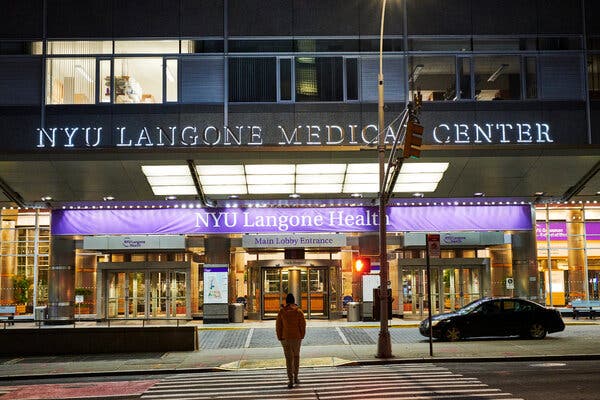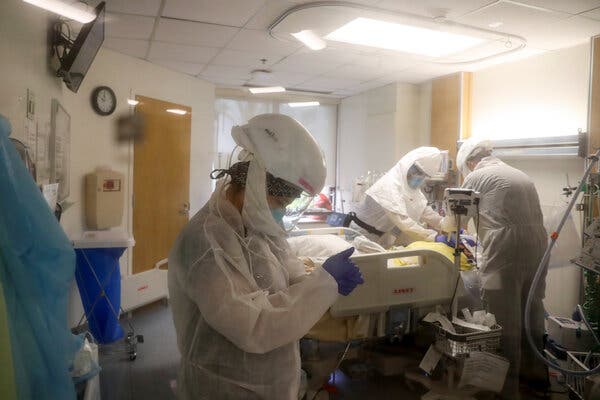Advertisement
Supported by
Buoyed by Federal Covid Aid, Big Hospital Chains Buy Up Competitors
The pandemic barely dented the financial outlook for some major networks, which continued to acquire weaker hospitals and ailing doctors’ practices. Critics worry consolidation leads to higher prices for medical care.

Billions of dollars in Covid aid cushioned financial losses caused by the pandemic at some of the nation’s largest hospital chains. But those bailouts also helped sustain the big chains’ spending sprees as they expanded even more by scooping up weakened competitors and doctors’ practices.
More consolidation by several major hospital systems enhanced their market prowess in many regions of the United States, even as rural hospitals and underserved communities were overwhelmed with Covid patients and struggled to stay afloat.
The buying spree is likely to prompt further debate and scrutiny of the Provider Relief Fund, a package of $ 178 billion in congressional aid that drew sharp criticism early on for allocating so much to the wealthiest hospital systems, and that had no limits on mergers and acquisitions.
The Biden administration is now weighing which hospitals and health providers will get the remaining $ 25 billion.
“It was not the intent to be a capital infusion to the largest and most financially stable providers to allow them to simply grow their slice of market share,” said Representative Katie Porter, Democrat of California. She is calling for hearings and for the Federal Trade Commission to review whether the funds were properly used for patient care and operations.
The hospitals say the Covid aid played no role in these deals, some of which were in the works before the pandemic. Major hospital chains argue that their size and reach helped them better care for patients, allowing them to divert supplies and people to hard-hit areas during the health crisis.
“Consolidated systems have saved lives during Covid,” said Dr. Rod Hochman, the chief executive of Providence, a large chain, and chairman of the American Hospital Association, at a Senate hearing this week.
Lawmakers on both sides of the aisle are pushing for greater oversight of hospitals. In the hearing on Wednesday, Senator Amy Klobuchar, Democrat of Minnesota, asked for more resources so regulators could tackle “the vicious cycle” of hospital consolidation. “When mergers are anti-competitive, they must be stopped,” she said.
Major employers had warned Congress that bailouts to the health care industry could spur even more consolidation and lead to price-gouging in medical care. Some of the nation’s most powerful hospital chains, experts cautioned, would take advantage of the crisis, resulting in even higher prices for medical care that would wind up on the shoulders of private insurers, employers and individuals.
“The big well-resourced hospitals had, frankly, a banner year, and they are now in a position to swallow up these smaller, more vulnerable groups,” said Elizabeth Mitchell, the chief executive of the Purchaser Business Group on Health, which represents large employers like Boeing, Microsoft and Walmart that provide health benefits for their workers.

Congress provided capital to hospitals that did not need it, said Zack Cooper, a Yale health economist. An early critic, Mr. Cooper says he remains concerned about how the aid has fueled the expansion of already powerful systems. “Regulators should really be looking at the transactions occurring,” he said.
CommonSpirit Health, a Catholic nonprofit system that is one of the biggest hospital networks with about 140 hospitals in 21 states, received well over $ 1 billion in federal aid to counter any financial losses caused by the shutdowns of lucrative elective surgeries and higher Covid-related costs.
In January, one of its divisions merged with Virginia Mason health system in Seattle in a move that strengthened CommonSpirit’s sway in Washington State. It also picked up a small hospital network in Arizona and helped start a company to analyze patient data across 40 states.
“We have continued to prioritize growth,” Lloyd H. Dean, CommonSpirit’s chief executive, said at an investor conference earlier this year.
In Washington State, CommonSpirit’s newfound clout could lead to higher prices, said Glenn Melnick, a health economist at U.S.C. Sol Price School of Public Policy. It is already among the most expensive hospital systems in the nation, by one analysis. Big hospitals “get their tentacles in, and then they carve up the markets,” he said.
CommonSpirit says it ended 2020 with a small loss, in spite of the federal aid. In Washington State, it plans to expand access to care for low-income individuals, it said.
Several other big hospital chains that received some of the largest pandemic general-distribution grants, as identified by Good Jobs First, a research organization, are also buying up more facilities and staff.
Providence, a 51-hospital network, got about $ 1 billion in federal aid and bought two small public hospitals in Northern California last year. “These rural hospitals have been struggling financially with limited public funding,” the network said. “With Providence support, health care access will continue in these rural communities.”
Two New Jersey networks, which each received more than half a billion dollars in aid, set their sights on local hospitals. RWJBarnabas Health announced last November its takeover of Trinitas Regional Medical Center in Elizabeth, and Hackensack Meridian Health is trying to acquire Englewood Health over the objections of federal regulators.
“If anything, the pandemic delayed the signing of the definitive agreement as opposed to being the cause,” RWJBarnabas said in a statement.
NYU Langone Health, a large New York City hospital group that received over $ 500 million in aid, said it was “in the very early stages of exploring a relationship” with Long Island Community Hospital, the last remaining independent hospital on Long Island.
Many of these same big chains, shored up by federal grants, are now in better financial shape than they were before the pandemic. Many are sitting on billions of dollars in cash.
While most of the provider aid has been distributed, the Biden administration is expected to begin doling out the remaining funds, estimated at $ 25 billion of the original $ 178 billion, said Kristen O’Brien, a vice president for McDermott+Consulting in Washington, D.C. Hospitals are asking for more time to spend the money.
How the aid was spent has not been fully documented. While the larger hospital networks aggressively sought the funds from the start, smaller organizations, children’s hospitals and those in rural areas or serving large numbers of low-income patients had more difficulty securing the aid because of the way the funding formula was structured.
In a later round of funding decisions, officials with the Department of Health and Human Services reviewed applications more closely, and in some cases, reduced or denied requests, Ms. O’Brien said.
Grants given after the initial rush were more targeted, to those hospitals in Covid hot spots or rural areas. A few large chains, including HCA Healthcare and the Mayo Clinic, returned at least some of the money, in the wake of disclosures that wealthier hospitals had received far more aid while reporting healthy profits.
Overall, the aid program did prevent hospital closings, said Ken Marlow, a lawyer with K&L Gates in Nashville, who advises hospitals. “We haven’t seen a real avalanche of these distressed hospitals coming on the market.”
But some may no longer be able to resist takeovers or mergers. “Those providers are potentially more distressed as a result of the stress of the pandemic and will have to be thinking hard about the future, their survival,” said Torrey McClary, a lawyer with Ropes & Gray who also counsels hospitals.
Experts fear the aid program has had the opposite effect of what it was intended for — saving hospitals.
“I wouldn’t be surprised if we found, paradoxically, it accelerated centralization and consolidation,” said Dr. David Blumenthal, a former Obama administration health official and the president of the Commonwealth Fund, a nonprofit research group. “Even though it sustained smaller players, it enhanced the ambitions and capabilities of larger players.”
The pace of deals announced last year was on par with previous years, according to Kaufman Hall, a Chicago consulting firm. There were 79 hospital deals, down slightly from 92 in 2019.
In the first three months of 2021, the number was lower than the same period of 2019, but it included large transactions like the potential combination of two private equity-backed hospital chains, LifePoint Health and Ardent Health Services.
Other kinds of deals, like the hospital purchase of a physician practice, are small and often fly under the radar of regulators. Because they involve private organizations, they are not typically required to disclose the details.
The big systems have also continued to extend their control over doctors’ groups and related businesses. Tenet Healthcare, a for-profit chain that received more than $ 500 million in federal aid, announced a $ 1 billion purchase of 45 ambulatory surgery centers last December. “The government support we received was used solely for the purpose of providing Covid relief,” the company said.
Ascension, a large faith-based system that received more than $ 1 billion in aid, said in March that it was investing in a partnership to buy surgery centers. The company said, in a request for comment, that its investment funding in surgery centers predated the pandemic.
Some doctors’ groups, shut down for months on end, may feel driven into the folds of a larger tent to ensure that they remain financially stable.
In testimony before Congress last month, Leemore Dafny, a health economist at Harvard and a former federal antitrust official, urged lawmakers to pay special attention to patterns in these smaller transactions. “It is precisely during this time of change in the health care system that the risks of consolidation are highest and the rewards of vigilance will be greatest,” she said.
Many of the big spenders among the hospital chains already charge the highest prices, often more than twice what Medicare pays for the same procedure, according to a RAND Corporation analysis.
CommonSpirit, itself the result of the 2019 merger between Dignity Health and Catholic Health Initiatives, is among the most expensive hospital systems, according to RAND. And Dignity’s prices were three times Medicare’s rates.
Other pricey hospitals also announced deals. Banner Health, a system based in Phoenix with about 30 hospitals, acquired Wyoming Medical Center, the state’s largest hospital, in October. Banner received more than $ 400 million in federal aid, according to the Good Jobs First data. Banner said it provided the medical center with “critical resources during the pandemic.”
MultiCare a Tacoma, Wash., system that received nearly $ 300 million in federal aid, finalized its takeover of Capital Medical Center in Olympia last month. The network said the RAND analysis was flawed and the acquisition streamlined care.
In one case, regulators took a close look at the potential consequences of these deals. Last July, Cedars-Sinai, a Los Angeles hospital group that RAND calculated was charging three times the Medicare rates, announced it was taking over Huntington Hospital, with 619 beds in Pasadena, Calif. Cedars-Sinai received about $ 200 million in federal aid, in addition to tens of millions of dollars in other grants for treating increasingly high Covid patient caseloads as the crisis raged in California.
An analysis conducted for state regulators found Huntington’s prices could increase by as much as 32 percent if it merged with Cedars-Sinai and wielded that combined negotiating power.
Cedars-Sinai and Huntington sued the California attorney general in March, seeking to prevent the state from capping Huntington’s prices and restricting consolidated negotiating power. Those limits were ordered by Xavier Becerra, the state attorney general for California who is now the nation’s Health and Human Services secretary.
“We are shocked at the unprecedented overreach of the conditions being imposed,” said Dr. Lori J. Morgan, the chief executive of Huntington Hospital, in a statement. “Rather than benefiting our community, the conditions primarily benefit health insurance companies.”
Cedars-Sinai said the acquisition would reduce costs. “Without affiliation, stand-alone hospitals such as Huntington face significant obstacles to their long-term ability to serve the community,” it said.
Federal regulators are also challenging the Englewood Health-Hackensack Meridian merger in New Jersey over concerns it would raise prices. While Hackensack said the deal was in the best interest of patients, a hearing before an administrative judge is scheduled for this summer.
Advertisement

